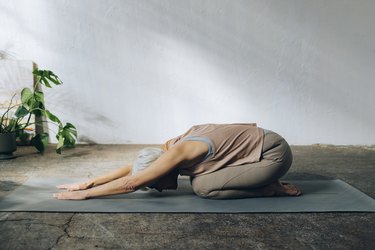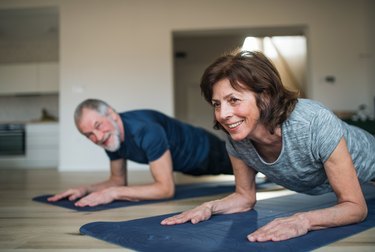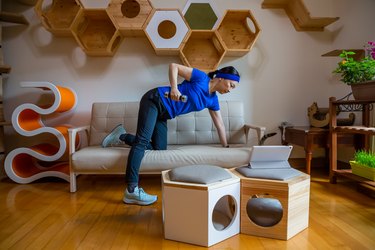

Even if stretching has never been one of your exercise go-to's, there's no time like the present to start a new flexibility routine.
Regular stretching is crucial for anyone who wants to move with ease and comfort as they age. After all, you don't want your flexibility to stop you from reaching a top-shelf cookie jar, right? And there are a few specific stretches to keep on your radar throughout the decades.
Video of the Day
The coolest part? The best stretches for your 50s, 60s and 70s aren't actually too different from one another — all focusing on foundational moves that help open your hips, back and shoulders. But there are a few adjustments you can make each decade to make them more accessible. Read on to learn the best stretches for older adults and how to tweak them as you age.
The 3 Best Stretches for Your 50s
In your 50s, you may start feeling noticeable changes in your flexibility, according to Melissa Garcia, DPT, CSCS, a Washington-based physical therapist at Bespoke Treatments. You may notice a little more difficulty getting up from the floor, reaching for objects on a high shelf or getting onto your bed.
"[The] downsides to losing flexibility is that things that you do every day start to seem a lot harder," she says. "Eventually you have to compensate to work around the inflexibility and eventually may lose the ability to perform the task altogether."
So, for this age group, maintaining muscle stretch is the priority. These three moves will stretch your whole body forward, back and side to side to target multiple planes of motion.
Move 1: World's Greatest Stretch
- From a high plank position, step your left foot to the outside of your left hand so you’re in a low lunge.
- Twist to your left side, reaching your left arm toward the ceiling and opening your chest.
- Bring your left elbow to the inside of your right foot, then reach your right arm toward the ceiling again.
- After 30 seconds, return to a high plank position, then switch sides.
Tip
Garcia loves doing the world's greatest stretch before or after a workout. Or, you can even try it in the middle of your work day after sitting for a long period of time.
Move 2: Downward Dog
- Start on all fours, tuck your toes under and lift your hips up, straightening your legs.
- Draw your shoulders down your spine away from your ears.
- Depending on your flexibility, bring your heels down toward the ground or stay on the balls of your feet with your knees bent.
- After 30 seconds, bring your knees back down to the ground in the starting position.
Tip
Do you struggle with downward dog? You may need to give your upper-body flexibility a little extra attention with a few shoulder stretches.
Move 3: Lying Figure 4 Windshield Wiper
- Lie flat on your back with your knees bent and feet flat on the ground.
- Cross your right ankle over your left knee, creating a figure 4.
- Keeping your upper body still and maintaining the figure 4, allow your legs to gently fall to the right until your right knee comes in contact with the ground.
- Hold here for 30 seconds and return to the starting position.
- Repeat on the opposite side.
The 3 Best Stretches for Your 60s
Age-related muscle loss starts ramping up in your 60s. And often, a loss of mobility comes with it, according to Garcia. (FYI, flexibility is the ability of your muscles to stretch. Mobility is how well your joints move.)
"In older age, declining mobility affects someone's independence in performing everyday tasks," she says. In this decade, a consistent stretching and mobility practice is needed to help prevent pain and maintain your comfort performing daily activities (like walking up and down the stairs or reaching above your head).
In your 60s, you also want to focus on more sensitive parts of your body, like your spine. Swapping downward dog for child's pose and simplifying your windshield wipers makes these stretches a little less intense on your back.
Move 1: Child's Pose
- Kneel on your knees on the ground.
- Sit back on your heels and stretch your arms forward, relaxing your forehead to the floor.
- Feel your lower back, hips and waist lengthening as you tap into your deep breathing.
- Stay in the pose for eight to 10 breaths.
Tip
Keep this movement slow and controlled with a nice, long hold at the end, Garcia says. "I personally do this one a lot when my lower back gets stiff."
Move 2: Lying Windshield Wipers
- Lie flat on your back with your knees bent and feet flat on the ground.
- Keeping your upper body still and maintaining the bend in your knees, allow your legs to gently fall to the left until your right knee comes in contact with the ground.
- Hold here for 30 seconds and return to the starting position.
- Repeat on the opposite side.
Move 3: Half-Kneeling Bow and Arrow
- Kneel on the ground with your knees at hip-width distance, arms straight out in front of you.
- Bend your right knee to 90 degrees and place your foot flat on the ground in front of you.
- Keeping your left arm in place, draw your right right elbow back as if you're pulling an arrow in a bow.
- At the same time, twist your torso to your right and look behind you. Pause here for a moment.
- Then return to the starting position.
- Repeat for 30 seconds and then switch sides.
Tip
Use a wall or chair for extra support if you struggle to keep good form during this movement.
The 3 Best Stretches for Your 70s and Beyond
Avoiding pain is important when moving in your 70s, so never push through stiffness or aches while you stretch, Garcia says. In this decade, your body's ability to heal and recover can slow significantly, so staying injury-free is at the top of the list.
For some extra comfort, do any seated or lying-down stretches on cushioned surface, like a bed or padded yoga mat. Have something sturdy, like a chair, table or bed, at your side for support if you need a little extra assistance getting up, Garcia recommends.
For many people in this age group, maintaining balance is a challenge. That's why all these stretches are all done in a seated or lying-down position, so you can focus on the stretch in your muscles without the risk of falling.
Move 1: Side-Lying Thoracic Rotation
- Lie on your left side with your legs stacked and bent at 90 degrees.
- Stack your arms straight out in front of you at shoulder height.
- Keeping your lower body still, open your right arm out to your right, forming a T shape.
- At the same time, turn your head to the right and open your chest up to the ceiling.
Move 2: Seated Lat Stretch
- Sit in a chair with your feet flat on the ground.
- Place a Swiss ball in front of you.
- Lean forward, keeping your back as flat as possible and straighten your arms across the ball.
- Let your head drop between your hands and continue to lean for ward as you ease into the stretch.
Tip
If you don't have a stability ball at home, you can do this same motion with the seat of a couch. Just face your chair toward the couch and use it as your support.
Move 3: Figure 4 Stretch
- Sit in a chair with your knees bent, feet flat on the floor.
- Cross you right foot over your left thigh.
- Gently lean forward as far as comfortable, holding your lower body in place.
Tip
To deepen this stretch, bend at your hip as you lean forward. Tight hips are common for anyone who sits for long periods of time and this stretch will give these joints some much-needed attention, Garcia says.


